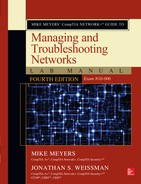Book Description
Practice the Skills Essential for a Successful IT Career
Mike Meyers’ CompTIA Network+ Guide to Managing and Troubleshooting Networks Lab Manual, Fourth Edition features:
- 80+ lab exercises challenge you to solve problems based on realistic case studies
- Lab analysis tests measure your understanding of lab results
- Step-by-step scenarios require you to think critically
- Key term quizzes help build your vocabulary
Get complete coverage of key skills and concepts, including:
- Network architectures
- Cabling and topology
- Ethernet basics
- Network installation
- TCP/IP applications and network protocols
- Routing
- Network naming
- Advanced networking devices
- IPv6
- Remote connectivity
- Wireless networking
- Virtualization and cloud computing
- Network operations
- Managing risk
- Network security
- Network monitoring and troubleshooting
